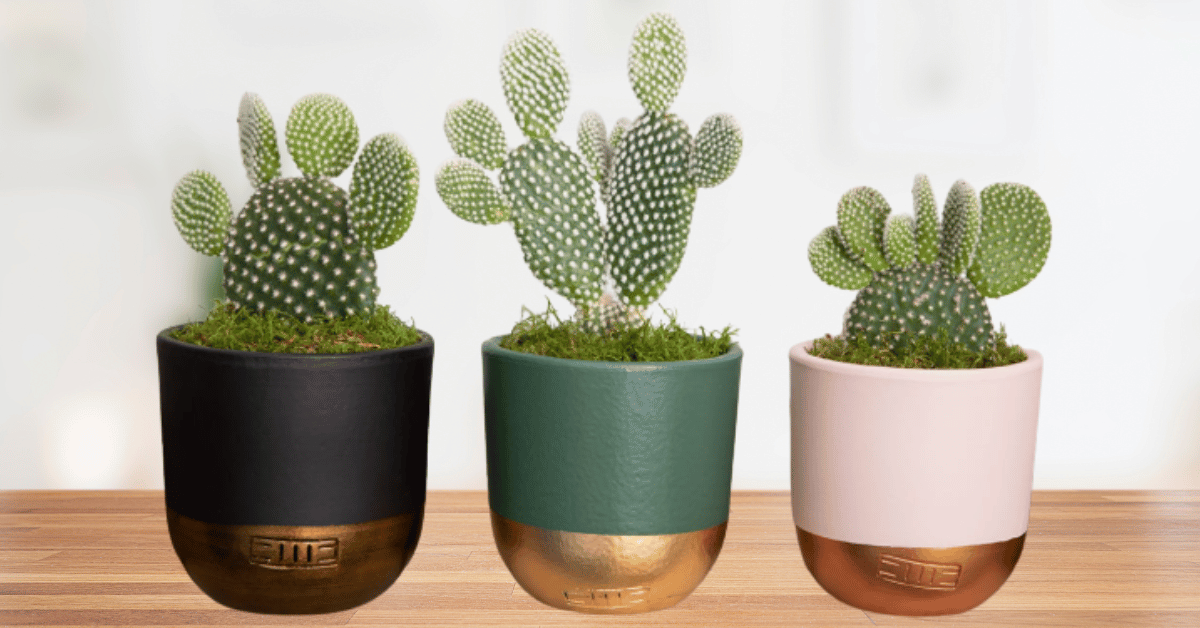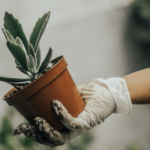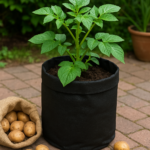The Bunny Ear Cactus (Opuntia microdasys) is a charming succulent native to central Mexico, easily recognized by its paired, fuzzy pads that resemble rabbit ears. Over the past decade, it has surged in popularity among indoor gardeners and desert landscapers alike due to its playful form and minimal care requirements.
Beyond aesthetics, this cactus is remarkably resilient. It thrives on neglect, needing bright light, infrequent watering, and well-draining soil. Beginners appreciate its forgiving nature: even if you forget to water for weeks, it bounces back quickly when you resume care. Advanced collectors value its ability to propagate from single pads in just a few weeks, allowing you to expand your collection or share pups with friends. Finally, its subtle yellow flowers in spring add a seasonal surprise, contrasting beautifully against the green pads. Whether you’re decorating a minimalistic living room or curating a drought-tolerant garden, the Bunny Ear Cactus delivers both whimsy and ease—truly the perfect “starter” succulent with personality.
About Bunny Ear Cactus

Native to the arid regions of central Mexico, Opuntia microdasys thrives in deserts and rocky terrains. In its natural stomping grounds, it forms dense clusters of pads that help conserve moisture and ward off herbivores with tiny, hair-like glochids (more on those soon!).
Its whimsical appearance and forgiving nature have catapulted the Bunny Ear Cactus to superstar status among indoor and outdoor succulent collections. From Instagram feeds filled with pastel planters to minimalist terrariums, this cactus adds a playful flair wherever it lives.
Botanical Characteristics
Understanding the Bunny Ear Cactus’s anatomy helps you appreciate its survival strategies and handle it safely.
- Pads (Cladodes)
- Flattened, oval segments that store water.
- Each pad measures 2–8 inches long and 1–3 inches thick.
- Growth occurs at the pad edges, forming new pads in pairs.
- Flattened, oval segments that store water.
- Areoles and Glochids
- Areoles are small, fuzzy spots from which glochids emerge.
- Glochids are microscopic, barbed hairs—more irritating than traditional spines.
- They detach easily; handle with thick gloves or tongs.
- Areoles are small, fuzzy spots from which glochids emerge.
- Flowers and Fruits
- Summer blooms: pale yellow, 2 inches wide, lasting 1–2 days.
- Flowering triggered by consistent warmth and bright light.
- Fruits are small, reddish-purple “tunas,” edible but mealy in texture.
- Summer blooms: pale yellow, 2 inches wide, lasting 1–2 days.
- Root System
- Shallow, fibrous roots optimized for rapid water uptake after rare desert rains.
- Sensitive to waterlogged soil; root rot sets in if drainage is poor.
- Shallow, fibrous roots optimized for rapid water uptake after rare desert rains.
These traits enable O. microdasys to flourish in arid, rocky habitats by maximizing water storage and minimizing water loss. The glochids also deter herbivores without the risk of large injuries. Appreciating these botanical features empowers you to replicate its natural desert environment—bright light, crisp airflow, and fast-draining substrate—for a healthy, thriving plant.
Ideal Growing Conditions

By ensuring ample light, maintaining warm and dry air, and using gritty, free-draining soil, you’ll recreate the Bunny Ear Cactus’s desert niche. This foundation makes all subsequent care—watering, fertilizing, and propagation—straightforward, reducing stress for both plant and grower
To mimic the Bunny Ear Cactus’s native desert home, pay close attention to light, temperature, and soil.
- Light Requirements
Bright light is non-negotiable. Place your Bunny Ear Cactus in a sunny windowsill or under a grow light that provides at least 6–8 hours of indirect sunlight daily. Direct midday sun may scorch the pads, so morning or late afternoon rays are ideal.
- Bright, indirect sunlight: 6–8 hours per day.
- Avoid midday scorch: Filter intense sun through a sheer curtain.
- Supplemental grow lights: Use in low-light interiors (LED spectrum 4000–6500 K).
- Temperature and Humidity
Comfortable in temperatures from 65°F to 85°F (18°C–29°C), this cactus can tolerate occasional dips to 50°F (10°C) but should be protected from frost. It loves low humidity—too much moisture in the air can encourage fungal issues.
- Optimal range: 65–85 °F (18–29 °C).
- Minimum tolerance: Drops to 50 °F (10 °C), but no frost.
- Low humidity: Below 40% relative humidity; high moisture invites rot.
- Soil and Potting Mix
A free-draining cactus mix or a blend of potting soil, coarse sand, and perlite (or pumice) works wonders. The goal is to prevent water retention that could lead to root rot.
- Cactus/succulent mix: Commercial blends with sand, perlite, pumice.
- DIY alternative: 50% potting soil + 25% coarse sand + 25% perlite.
- pH preference: Slightly acidic to neutral (pH 6.0–7.0).
- Pot Selection
- Terracotta or unglazed ceramic: Promotes moisture evaporation.
- Drainage holes: Mandatory to prevent water accumulation.
- Terracotta or unglazed ceramic: Promotes moisture evaporation.
Planting and Propagation

Expanding your Bunny Ear Cactus collection is both fun and cost-effective. Two main methods include cuttings and seeds.
- Selecting Healthy Pads
- Choose firm, wrinkle-free pads, approximately 3–4 inches long.
- Inspect for blemishes, discoloration, or pest damage.
- Choose firm, wrinkle-free pads, approximately 3–4 inches long.
- Propagation by Cuttings
- Sterilize a sharp knife with alcohol.
- Slice at the juncture between pads.
- Air-dry for 5–7 days in a shaded spot to form a callous.
- Plant upright (calloused end down) in a dry cactus mix—don’t water immediately.
- After 1–2 weeks, mist lightly; roots emerge in 3–4 weeks.
- Sterilize a sharp knife with alcohol.
- Seed Propagation
- Sow seeds on moist, sandy surface; cover lightly with sand.
- Maintain 75–85 °F (24–29 °C) and moderate humidity.
- Germination in 2–4 weeks; keep soil just damp, not waterlogged.
- Sow seeds on moist, sandy surface; cover lightly with sand.
- Tips for Success
- Label cuttings with date and source.
- Use rooting hormone powder to boost success rates.
- Provide bottom heat (~70 °F) for faster root development.
- Label cuttings with date and source.
Cuttings offer a quicker route—new pads form in under two months—while seeds produce genetic diversity and satisfy aficionados. Both approaches deepen your gardening skills and multiply your delightful Bunny Ear Cactus display.
Watering and Fertilization
Finding the perfect balance of water and nutrients is crucial for a thriving Bunny Ear Cactus. Before you water, always check that the top inch of soil is completely dry—use a wooden skewer or simply press your finger into the mix. In spring and early summer, when new pads are forming, aim to water every two to three weeks, increasing slightly during hot, dry spells; then taper off in autumn to every four to six weeks, and reduce still further in winter dormancy to once every six to eight weeks. Always water deeply until excess drains from the pot’s base, then allow the container to dry out fully, and avoid wetting the pads to prevent rot. For nourishment, apply a balanced cactus fertilizer (for example, 10-10-10 NPK) at half strength twice during the growing season—once in early spring and again in midsummer—while suspending feeding entirely in autumn and winter. When you see firm, plump pads with one to three new pads emerging each season, you’ll know your watering and fertilization routine is right on track. Err on the side of underwatering—this cactus is drought-adapted and prone to root rot if overwatered.
- General Watering Principles
- Water only when soil is completely dry.
- Insert a wooden skewer; if it comes out clean and dry, it’s time.
- Frequency: every 2–4 weeks in growing season, every 6–8 weeks in dormancy.
- Water only when soil is completely dry.
- Seasonal Schedule
- Spring (Mar–May): Moderate watering, encourage new growth.
- Summer (Jun–Aug): Slightly more frequent; monitor weather.
- Autumn (Sep–Nov): Gradually reduce as temperatures drop.
- Winter (Dec–Feb): Minimal—sometimes skip months.
- Spring (Mar–May): Moderate watering, encourage new growth.
- Fertilizer Guidelines
- Use a balanced 10-10-10 or specialized cactus fertilizer.
- Dilute to half strength to prevent “fertilizer burn.”
- Apply twice per growing season: early spring and mid-summer.
- Use a balanced 10-10-10 or specialized cactus fertilizer.
- Signs You’re Doing It Right
- Pads remain plump, firm, and upright.
- New pads develop at moderate pace (1–2 per season).
- No yellowing or sogginess at the base.
- Pads remain plump, firm, and upright.
Consistent, conservative watering paired with light feeding optimizes health and blooming potential. Skip fertilization entirely if you’re new—observe how your cactus responds over one growth cycle before adjusting nutrients.
Common Pests and Diseases
Although resilient, the Bunny Ear Cactus can attract pests or succumb to rot under poor conditions.
- Mealybugs
- White, cottony clusters in pad crevices.
- Suck sap, causing yellowing and distortion.
- Treat: dab with isopropyl alcohol on a cotton swab; repeat weekly.
- White, cottony clusters in pad crevices.
- Scale Insects
- Brown or gray shell-like bumps.
- Hard to remove; scrape gently after softening with soapy water.
- Follow up with horticultural oil spray.
- Brown or gray shell-like bumps.
- Fungal Infections & Root Rot
- Triggered by soggy soil or high humidity.
- Symptoms: soft, discolored pads; foul odor at soil line.
- Remedy: unpot, trim rotten roots with sterilized scissors, let callous, repot in fresh dry mix.
- Triggered by soggy soil or high humidity.
- Preventative Measures
- Quarantine new plants for 2–3 weeks.
- Ensure good airflow; avoid enclosed terrariums.
- Water at soil level—keep pads dry.
- Quarantine new plants for 2–3 weeks.
- Regular Inspection
- Check weekly under bright light.
- Early detection means easier treatment and less lasting damage.
- Check weekly under bright light.
Pruning and Maintenance
When and How to Prune
Pruning your Bunny Ear Cactus is best done in spring, just as new growth begins. Grab a pair of sterilized shears (or a sharp knife) and snip away any pads that are damaged, discolored, or crowding the cluster. Always make clean cuts at the base of the pad, letting the wound callous over in a dry, shaded spot for a few days before returning the cutting to its spot or potting it for propagation. Wear thick gloves or use tongs—those glochids may look fluffy, but they’re delightfully prickly to handle!
Dealing with Leggy Growth
Leggy growth happens when your cactus stretches toward light that’s just out of reach. If you notice long, thin pads and wide gaps, first move the plant to a brighter spot. Then, prune back the lanky sections to encourage new, compact pads lower on the stem. You can re-root the trimmed pads the same way you’d propagate any cutting. Over time, you’ll end up with a fuller, more balanced plant—that’s just like giving your cactus a fresh hairstyle!
Container Growing vs. Ground Planting
Benefits of Container Culture
Growing your Bunny Ear Cactus in a container means total control: you can move it to chase the sun, slip it inside when temperatures dip, and monitor soil moisture at a glance. Containers also let you experiment with stylish pots—terracotta, glazed ceramic, or even whimsical animal-shaped planters—to suit your décor. Plus, you’ll avoid potential pitfalls of garden pests, and if root rot ever threatens, you can quickly unpot, treat, and repot without disturbing a whole bed.
Tips for Outdoor Planting
If you choose to plant in the ground, pick a spot that basks in full or afternoon sun with fast-draining soil—think sandy, rocky, or gravely. Amend heavy clay with coarse sand or pea gravel so water won’t pool around roots. In climates with occasional frost, mounding the soil into a raised bed will enhance drainage and let cold air flow beneath. Finally, add a layer of decorative gravel on top to prevent weeds, mimic its desert roots, and give your Bunny Ear Cactus that showroom look.
Design Ideas and Landscaping Uses

Rock Gardens and Succulent Arrangements
Imagine a miniature desert ecosystem: low-lying sedums, stiff yuccas, spiky agaves, and the playful polka-dot pattern of Opuntia microdasys. Nestle your Bunny Ear Cactus among flat stones or boulders, using the contrast of smooth rock and fuzzy pads to create depth and texture. Grouping various succulents with staggered heights will look like a tiny mesa, and a gravel mulch will lend authenticity while keeping moisture at bay—just the way our cactus friends prefer it.
Indoor Décor and Terrariums
Yes, you can tuck a Bunny Ear Cactus into an open terrarium or modern planter as a statement piece. Pair it with trailing succulents—like String of Pearls—to soften the silhouette, or surround it with air plants and crystals for a boho vibe. The key is ventilation: choose open-top glass containers or pots with wide mouths, so humidity doesn’t climb and foster rot. A sunny windowsill or a bright shelf will make your living room feel like a desert oasis.
Seasonal Care Guide
Spring Revitalization
Spring is growth season: lightly repot if roots are crowded, replace old soil, and check for overwintering pests. As temperatures climb, you can gradually increase watering frequency—always observing the “soak and dry” principle. A half-strength dose of cactus fertilizer in early spring gets pads plumping and primes the plant for that first flush of new growth.
Summer Peak Growth
By mid-summer, your Bunny Ear Cactus is in full swing. Keep it in bright light, shield it from scorching midday rays, and water every two to three weeks if the soil dries out completely. Look forward to those pale yellow blooms—if conditions are right, you might catch them opening at dawn for a day-long show before the heat wanes.
Autumn Preparation
As days shorten and temperatures dip, gradually taper off watering to let the cactus settle. Dust off pads and inspect for bugs one last time before cooler months set in. If you’ve potted your cactus, consider moving it to a slightly cooler, bright spot—around 60–65 °F (15–18 °C)—to signal it’s time to slow down.
Winter Dormancy
Winter calls for minimal interference. Water perhaps once every six to eight weeks, only if pads begin to shrivel. Keep your cactus in a cool (50–60 °F/10–15 °C), bright location—an unheated sunroom or a chilly, sunny windowsill works wonders. Hold off on fertilizing until the first hints of spring warmth return.
Troubleshooting Guide
Yellowing or Drooping Pads
Yellow or droopy pads typically mean overwatering or poor light. First, lift the pot and let it dry out completely. Then, relocate your cactus to a brighter spot—morning sun or an east-facing window is ideal. If pads are soft, gently remove them, let the cut ends callous, and replant in fresh, dry soil.
Slow Growth Issues
If your cactus seems stuck in slow-mo, it might need more light, better nutrients, or room to stretch roots. Ensure at least 6–8 hours of bright light, feed with diluted cactus fertilizer in spring, and repot every 2–3 years to refresh the soil and give roots space.
Overwatering Signs
Mushy pads, black spots at the base, or a musty odor at the soil line scream “too much water.” Immediately unpot the plant, remove any rotten roots, let everything callous for a few days, then repot in a fresh, bone-dry mix. Going forward, lean into underwatering—this species thrives when you hold back.
Companion Plants
Succulents That Pair Well
Bunny Ear Cactus teams beautifully with fellow drought-lovers like Echeveria, Haworthia, and Sedum. Their varied leaf shapes—from rosettes to spires—bring contrast, while similar water needs simplify care. Group them in a shallow dish garden or a gravel-topped pot for a cohesive, low-maintenance display.
Complementary Flowering Species
For seasonal blooms, tuck in golden marguerite (Anthemis tinctoria) or Blanket Flower (Gaillardia) nearby in your landscape. Their bright yellow or red-orange petals echo the cactus’s subtle flowers and attract pollinators. Just be sure they share well-draining soil and full sun.
Fun Facts and Cultural Significance
Name Origins and Folklore
The common name “Bunny Ear Cactus” is a nod to its twin pads, but in Mexico, it’s often called the “Polka-Dot Cactus” for its dotted areoles. Some folk tales say spotting one in bloom brings good luck, sheltering travelers from misfortune under its prickly canopy—though, of course, you’d keep a respectful distance!
Uses in Traditional Medicine
While Opuntia species have been used for anti-inflammatory treatments and as a dietary supplement, O. microdasys itself sees little direct medicinal use—likely due to its tiny glochids. However, its relatives are steeped in history: indigenous communities have long tapped pads and fruits of other prickly pears to soothe wounds, regulate blood sugar, and treat digestive issues.
Conclusion
From its adorable “rabbit ear” silhouette to its forgiving care requirements, the Bunny Ear Cactus (Opuntia microdasys) has earned its place in gardens and homes around the world. By understanding when to prune, how to water, and which companions to pair it with, you’ll enjoy a resilient, eye-catching centerpiece that thrives on neglect. Whether you’re planting in a decorative container or a sun-baked rock garden, this cactus will reward your effort with healthy, bouncing pads and the occasional yellow bloom—proof that even in minimalism, nature knows how to delight.
FAQs
- How do I remove glochids if I accidentally brush my skin?
Gently press duct tape or masking tape onto the affected area and peel away; repeat until the tiny hairs lift off. Then wash with soap and water. - Can Bunny Ear Cactus tolerate full, direct sun all day?
It prefers bright light but can scorch under intense midday rays. Aim for morning or late afternoon sun and filter harsh light when needed. - Why aren’t my pads producing flowers?
Lack of bright light or insufficient warm days can delay blooming. Ensure 6–8 hours of good light and consistent spring–summer warmth. - Is it safe to grow this cactus around pets and children?
The glochids can irritate skin and eyes. Keep it out of reach or in a spot where curious paws and hands can’t venture. - What’s the best way to propagate multiple pads at once?
After callousing cut pads, place them slightly apart in a tray of dry soil and mist weekly. Roots will form in 3–4 weeks, and you can pot them individually once they’re stable.







